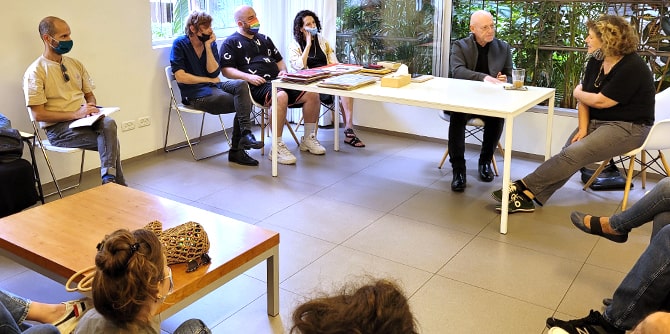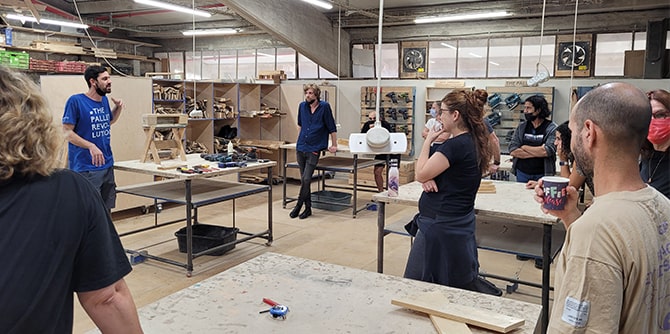Together with program directors Professor Dana Arieli and ,strong>Dr. Hagit Damari, the fellows of Cohort 4 of the Mandel Program for Cultural Leadership in the Negev embarked on a two-day study retreat designed to enable them to review and process their study unit on visual culture and its power to drive change.
Visual culture is a theoretical and critical field relating to anything that is exposed to human view. The study of visual culture focuses both on visible space, and on the mechanisms that play a role in its construction. The underlying premise of the field is that the act of viewing is never neutral; rather, it is mediated by bodies of knowledge, power struggles, desires, and ideologies that seek to imbue the visual with different and changing meanings.
The retreat began at the Weizmann Institute of Science, where the fellows learned about how the Institute presents the relation between science and scientific institutions and the visual. As they walked through the campus, the fellows noted its landscaping and environmental sculptures, the typography on its buildings, and the spatial design of the laboratories. An architectural tour, which began with the historic home of Vera and Chaim Weizmann, showcased the international style of Erich Mendelsohn, several buildings in the brutalist style, and glass buildings of the 21st-century. A conversation with Yivsam Azgad, the Institute’s art curator, revealed a fascinating policy that brings together science and art, as well as scientists and artists.

From Rehovot, the fellows continued to Tel Aviv, where they explored a series of visual statements that embody different relations between components of identity and social and political questions. They began at an exhibition attempting to expand the boundaries of the concept of “climate change” so that it can serve as a metaphorical tool for examining questions relating to the climate of gender. A conversation with the exhibition curator, Erez Bialer, explored representations of the male body in contemporary art. In the evening, on the roof of the gallery, the fellows met with performer and fashion designer Kay Long and discussed the relations between fashion, identity, periphery, and center.
On the second morning, the group visited the studio of Gary Goldstein, an artist whose visual grammar is taken from old movie posters, billboards, and movements such as pop art, surrealism, and Dadaism. Goldstein, who was born in the South of the United States and was raised in Connecticut by his Holocaust-survivor parents, described his work as a constant attempt to process the demons and shadows that stem from the horrors of his family’s past.
From the intimate and the personal, the fellows moved on to observing visual statements in public spaces. They took a tour with photographer Vered Navon, who led a struggle to save 40 ficus trees on Jerusalem Boulevard in Jaffa, based on research of old photographs of the street. The fellows’ interaction with the boulevard, its passersby, and the architectural geology surrounding the boulevard, provided important insights into the links between visual displays and national myths, romantic yearnings, and economic interests.

The retreat concluded with a visit to the Design Terminal in Bat Yam, a social design compound in a renovated warehouse that includes a rehabilitation facility, a common yard, and an incubator for designers which collaborates with the rehabilitation initiatives. Liron Hershkovitz, CEO and co-founder of Out of the Box, the nonprofit behind the Terminal, spoke with the group about design as a tool for economic, social, and cultural change. At the MOLET studio in the compound, the fellows learned about upcycling – the process of recycling and upgrading products and materials – and tried their hand at transforming wooden pallets into benches, planters, and toys.
During the study unit on visual culture, the group examined the ways in which different scopic regimes affirm what is obvious and widely accepted. The retreat offered a range of opportunities for the fellows to disrupt their own perspectives and to think about disruption as a first, necessary step in planning beneficial social change.

